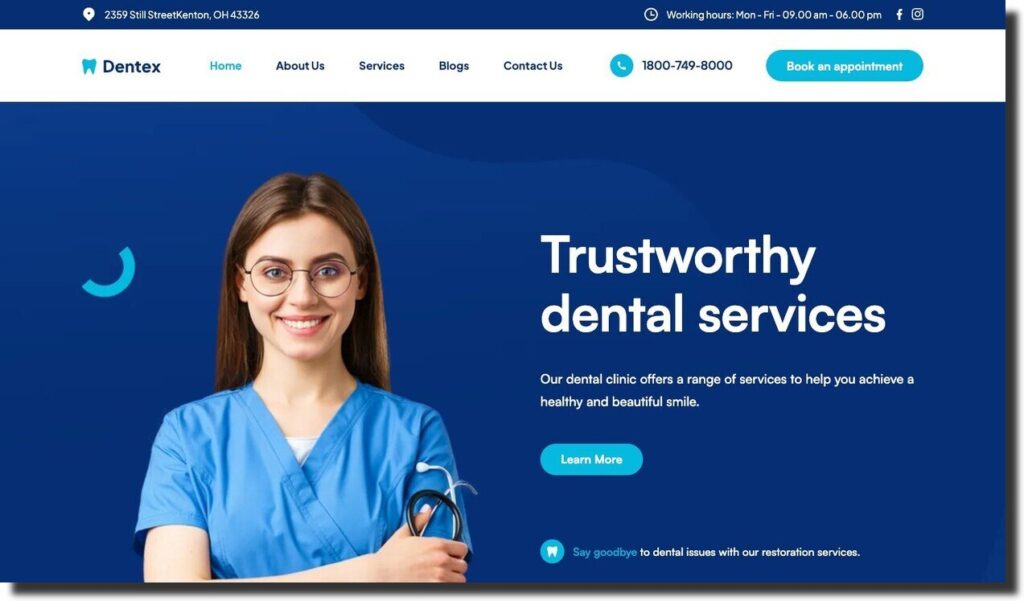
In today’s digital age, a dental practice’s website serves as more than just an online brochure; it is a crucial tool for attracting and converting potential patients. A well-designed dental website can instill trust, provide essential information, and ultimately guide visitors toward scheduling an appointment. Understanding the key elements that make a dental website effective is essential for practice growth and patient engagement dental websites.
Understanding the Purpose of a Dental Website
A dental website serves multiple functions. Primarily, it informs potential patients about services, staff credentials, office location, and patient experiences. Beyond information delivery, a dental website acts as a marketing tool. By presenting a professional and approachable online presence, it encourages visitors to take action, whether booking an appointment, signing up for a newsletter, or calling the office for inquiries. The most successful dental websites are those that seamlessly blend informative content with conversion-focused design elements.
User-Friendly Design
User experience plays a critical role in converting visitors into patients. A clean, uncluttered layout ensures that users can quickly find the information they need. Navigation should be intuitive, with clear menu options that direct users to services, about pages, contact information, and patient resources. Mobile responsiveness is equally important, as a significant portion of users access dental websites via smartphones or tablets. A site that is slow or difficult to navigate on mobile devices may drive potential patients away, resulting in lost opportunities.
Strong Branding and Visual Appeal
A professional visual design helps establish credibility and trust. High-quality images of the practice, staff, and treatment areas can make visitors feel more comfortable and familiar with the environment before even stepping in. Consistent use of colors, fonts, and logos reinforces the practice’s brand identity. Many dental websites benefit from featuring before-and-after treatment photos, which not only showcase the dentist’s skill but also help potential patients visualize results. Videos introducing the team or explaining procedures can further enhance engagement.
Clear and Compelling Content
Content is the backbone of any successful dental website. Each page should convey clear, concise, and informative messages. Services should be described in simple language, avoiding excessive medical jargon that could confuse readers. Creating blog posts or educational articles about dental health helps establish the practice as an authority in the field and improves search engine visibility. Testimonials from satisfied patients are particularly effective, as they provide social proof and reinforce trust. Incorporating the keyword “dental websites” naturally throughout the content also enhances search engine optimization (SEO) and helps the site appear in relevant searches.
Call-to-Action Placement
Strategic placement of calls-to-action (CTAs) is crucial for converting visitors into patients. Every page should encourage a next step, whether it’s scheduling a consultation, calling the office, or filling out an online form. CTAs should be visually distinct, using contrasting colors and persuasive language to prompt action. For instance, buttons like “Book Your Appointment Today” or “Request a Free Consultation” are more effective than generic labels. Dental websites that thoughtfully integrate CTAs at the right moments tend to see higher conversion rates.
Fast Loading Speed and Technical Optimization
A website’s technical performance directly impacts user experience and conversion rates. Slow-loading pages can frustrate visitors and increase bounce rates. Optimizing images, leveraging browser caching, and minimizing unnecessary scripts are essential steps to ensure a fast, smooth browsing experience. Additionally, proper SEO practices, including meta tags, alt text, and structured data, make it easier for search engines to index the site, ultimately driving more organic traffic.
Secure and Accessible Website
Trust is paramount in healthcare, and dental websites must communicate reliability and professionalism. Implementing HTTPS encryption signals security to visitors, particularly when they submit personal information through online forms. Accessibility is another important consideration. Ensuring the website is usable for people with disabilities not only broadens your audience but also aligns with legal requirements in many regions. Clear fonts, alternative text for images, and keyboard-friendly navigation enhance accessibility and overall user experience.
Integration with Patient Management Systems
Modern dental websites often benefit from integration with patient management systems. Online appointment scheduling, patient portals, and forms for new patients streamline the process of converting visitors into patients. When a potential patient can easily book an appointment directly through the website, the likelihood of conversion increases significantly. Such integrations also reduce administrative workload and improve overall patient satisfaction.
Local SEO and Online Visibility
Dental practices typically serve a local community, making local search optimization a critical factor. Optimizing the website for location-based keywords, claiming Google Business Profiles, and encouraging satisfied patients to leave reviews can dramatically improve visibility in local search results. Potential patients are more likely to choose a dentist who appears prominently when they search for dental services in their area. High visibility not only increases traffic but also builds credibility within the community.
Tracking Performance and Continuous Improvement
An effective dental website is never static. Monitoring website analytics allows practices to understand visitor behavior, identify popular pages, and track conversion rates. Tools like Google Analytics provide valuable insights into which elements are driving appointments and which may need adjustment. Regular updates to content, images, and technical components ensure the site remains relevant, engaging, and optimized for both users and search engines. Continuous improvement based on data-driven insights is key to maintaining a high-converting dental website.
Conclusion
Creating dental websites that convert visitors into patients requires a combination of design, content, usability, and technical optimization. By focusing on user-friendly navigation, compelling visuals, informative content, and strategic calls-to-action, dental practices can establish credibility and encourage prospective patients to take action. Integration with patient management systems, mobile responsiveness, fast loading speeds, and local SEO further enhance the website’s effectiveness. Ultimately, a well-executed dental website not only attracts visitors but also builds trust, provides valuable information, and converts interest into loyal patients, driving the growth of the practice in a competitive digital landscape.